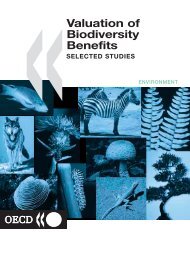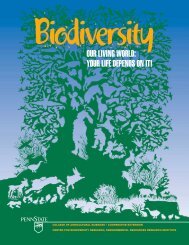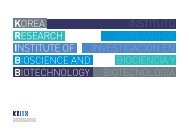Untitled
Untitled
Untitled
- No tags were found...
You also want an ePaper? Increase the reach of your titles
YUMPU automatically turns print PDFs into web optimized ePapers that Google loves.
Korea Biological Resource CenterMicrobialResource CenterRESEARCHERSJung-Sook Lee jslee@kribb.re.krManagement of KCTCManagement of bacteria and national bio R&D productsChang Jin Kim chanjin@kribb.re.krMicrobial diversity and biocontrol agentsKyung Sook Bae ksbae@kribb.re.krManagement of fungiSuk Weon Kim kimsw@kribb.re.krManagement of plant cell linesKee-Sun Shin ksshin@kribb.re.krManagement of yeast resourcesYoung-Hyo Chang yhchang@kribb.re.krManagement of anaerobesSong-Gun Kim sgkim@kribb.re.krManagement of plasmid resourcesByoung-Chan Kim bckim@kribb.re.krManagement of archaeaDoo-Sang Park dspark@kribb.re.krManagement of animal cell lines and DNA barcodingRESEARCH AREASManagement of biological resourcesCollection and preservation of core biological resourcesfrom foreign and domestic, and distribution of biologicalresources to academia, industry and researchersDevelopment of core technologies for valuablebio-resourcesDeveloping platform technologies for the management,preservation and taxonomy of useful biologicalresourcesConstruction of an information network and supportof various servicesConstruction of local and international network ofbiological resources and the related information andproviding support for workshops, conferences,consultations, etc.Director Jung-Sook LeeT + 82-42-860-4600F + 82-42-860-4677E jslee@kribb.re.krACHIEVEMENTSCollection, preservation and distribution of biological resourcesWe acquired over 1,700 strains, including bacteria, actinomycetes, yeasts, filamentousfungi, anaerobes, archaea, animal and plant cell lines, microalgae and patent strains, andpreserved about 65,000 cases for long-term preservation in 2010. KCTC was the thirdranked culture collection in the world in acquiring new microbial resources in 2010. Wedistributed over 5,000 strains to academia, industry, and researchers in 2010.Research activitiesWe published 48 papers related to biological resources and described 25 new species. Wealso registered 8 patents, including one international patent. We managed biologicalresources by barcode-based management system, IRIS, Information of Resource-IndexingSystem, v3.0, for the implementation of systematic and efficient management.Construction of an information network and support of various servicesWe constructed local and international networks of biological resource centers. We alsoconnected biological resource information through national and international databasesystems because one of our main services is to provide biological resource information topublic. We held four workshops and two conferences, and offered consultation andtechnical support for more than 7,000 cases in 2010.SELECTED PUBLICATIONSJung-Sook Lee (Corresponding) Int J Syst Evol Microbiol. 60(2):369-77.Halomonas stevensii sp. nov., Halomonas hamiltonii sp. nov. and Halomonas johnsoniaesp. nov., isolated from a renal care centreChang Jin Kim (Co-corresponding) Int J Syst Evol Microbiol. 60(9):2154-8.Haloechinothrix alba gen. nov., sp. nov., a halophilic, filamentous actinomycete of thesuborder PseudonocardineaeKee-Sun Shin (Corresponding) FEMS Microbiol Lett. 309(2):130-5.Mucilaginibacter dorajii sp. nov., isolated from the rhizosphere of Platycodon grandiflorumSong-Gun Kim (Co-corresponding) Appl Environ Microbiol. 76(17):5827-36.Identification and characterization of a novel Terrabacter ginsenosidimutans sp. nov. betaglucosidasethat transforms ginsenoside Rb1 into the rare gypenosides XVII and LXXVByoung-Chan Kim (Corresponding) Appl Environ Microbiol. 76(7):2371-5.Role of Geobacter sulfurreducens outer surface c-type cytochromes in reduction of soilhumic acid and anthraquinone-2,6-disulfonateYoung-Hyo Chang (First) J Clin Microbiol. 48(2):545-553.Application of rpoB and Zinc Protease gene on molecular discrimination of Fusobacteriumnucleatum subspecies.Doo-Sang Park (First) BMC Genomics. 11:423.Recovery of the mitochondrial COI barcode region in diverse Hexapoda through tRNAbasedprimersAs part of the national bio-infrastructure for biological resources, we are a biotechnology think-tank and performbio R&D. The main goal of the KCTC (Korean Collection for Type Culture) is to collect, preserve and distribute biologicalresources.48 KRIBB Annual Report 2010KRIBB Annual Report 2010 49












